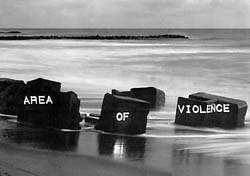German Luck

The Kunstraut Deutschland exhibition at the Center for Contemporary Art at the Kyiv-Mohyla Academy creates a somewhat motley and disjointed impression in terms of its artistic content.
Indeed, the authors of the displayed works are as renowned as they differ. Each has his own manner, genre, temperament, etc. The distance between pioneer of video and media art Nam June Paik with his monitors’ conglomerations and austere and rational conceptualist Joseph Kosuth or rather traditional herman de vries is immeasurable. Perhaps the only thing that unites these artists is the fact that each of them has lived and worked in Germany for some time. Certainly, one can only envy the Germans this.
However, what earlier seemed a sharp razor of radicalism now looks like cozy antiquity. This is what Paik’s Candle TV is like. A candle burning inside an empty case of an old, probably black-and-white television set provokes sentimental and lyrical feelings, as well as the same author’s Internet Dweller: an almost comical creature made of the cases of old radio and television sets with modern screens twinkling within, hanged round with rarity photo and television cameras. Across the hall from these samples of old-fashion television are Magdalena Jetelova’s super-modern compositions depicting World War II fortifications decorated with disquieting white graffiti as in her “Area of Violence.”
Jetelova’s works resemble in their form those by Kosuth. However, the latter are based on concepts different in principle. In fact, there is nothing in them but a concept, devoid of any means of expression as much as possible. The stream Kosuth adheres to for the last few decades is called conceptualism and not by chance. The CCA present several pictures rather typical for this artist: dictionary entries explaining the meaning of the words, purple, loudness, or skillet. Only words and letters, nothing more; though, the last installation is a true revolution, being accompanied with a real, rather heavy iron pan.
The works by herman de vries, who writes his name with a small letter on principle, look uncommonly balanced and almost classical compared to the others. There is something warm and even childish in his Meadow, dry grass on white paper, or the Two Days under a Thorn Hedge: October dry leaves applique.
In general, the exhibition, which was supposed to gather avant-garde leaders, looks rather traditional. A big part of the works are paintings, and very good ones. The plastic and saturated abstractions by Per Kirkeby (personally, I believe them best of all the works presented), Tony Cragg’s drawings, Armando’s energetic and expressive Flag 9-4-85, Ayse Erkmen’s Here and There painted metal objects are a true guide into contemporary styles of painting. In the course of the recent return to canvas, this looks rather modern.
Again, one can only envy the Germans who were able to notice and collect all these works on schedule. Just think how many world celebrities, founders of various trends in art, not only came through Ukraine but were born and grew up here, and how many works are left from them.






